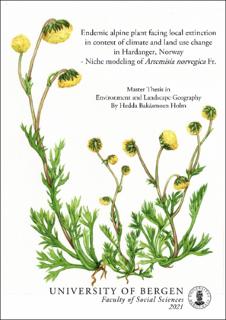| dc.description.abstract | Based on Hutchinson's niche theory, species need to move in space to stay within their climate niche during climate change. This thesis tests whether an upward range shift has occurred for Artemisa norvegica (Fr.) during the last 90 years at Dovre (main population). The thesis hypothesises that the lapse rate has decreased with warmer climates during the last three normal periods (1930-2020) due to climate change and elevational-dependent warming (EDW), i.e. a more rapid warming at a higher elevation than low-land. The main aim is to use the niche model based on data from Dovre to evaluate whether a subpopulation of A. norvegica at Mt Vassli in Hardanger is becoming locally mountain-top extinct. Two hypotheses were tested: extinction caused directly by warming or by the upward elevational movement of Betula pubescence that may outcompete A. norvegica for light based on the understanding of thermophilization. Generalized linear model (GLM) was used on frequency data (number of occurrences per 100-m elevation) and logistic regression on presence-absence data to estimate temperature optimum and tolerance range for the three normal climate periods and the total. The datasets were organised according to the three normal climate periods of 1931-1960, 1961-1990 and 1991-2020. Lapse rates for each normal period were calculated by linear least square regression between climate stations data, and EDW was interpreted from these results. An ordination was done on earlier vegetation data from Dovre, Hardanger, and new data (including subpopulation in Hjelmeland), which revealed two alpine ridge type habitats, and one habitat in screes and cliff. EDW of lapse rates varied in relevance between the two types of climates. It was confirmed for the Dovre area, whereas not detected in Western Norway. A. norvegica has moved upwards in the past 90 years at the average speed of 2.5 meters per year. Consequently, its elevation optimum has ascended, however its temperature optimum has increasingly become cooler. B. pubescens also moved to higher elevations nationally and locally at Mt Vassli. Climate projections imply that the future temperature optimum of the target species is at a higher elevation than what Mt Vassli can facilitate. Thus, this subpopulation may become locally mountain-top extinct as there is no land to track its niche. A. norvegica is known to have a high heat tolerance, and therefore the temperature is not necessarily expected to be a mortal factor, but B. pubescence is mowing upwards nationally and locally at Mt Vassli, thus the light-demanding alpine ridge plant A. norvegica may be outcompeted for light. | |
